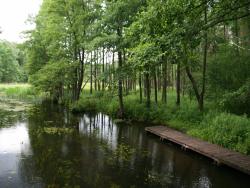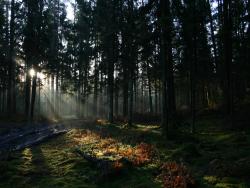 Asset Publisher
Asset Publisher
Polish forests
Poland is in the European lead, while concerning the area of all forests. They cover about 29,2 % of the country territory, and grow within the area of 9,1 million hectares. The overwhelming majority of the forests is state owned, of which almost 7,6 million hectares are managed by the State Forests National Forest Holding..
The number of Polish forest is still growing. The forestation rate of the country has increased from 21 % in 1945 to 29,2 % at the moment. Between 1995 and 2008, the forest area increased by 310 thousand ha. The basis for afforestation works is the "National Programme for Increasing the Forest Cover" (KPZL), assuming an increase of the forestation rate up to 30 % by 2020 and up to 33 % by 2050. Polish forests abound in flora, fauna and fungi. 65 % of the total number of animal species live there.
The forests grow in our country on poor soils, mainly because of the development of the agriculture in previous years. It influences the distribution of the types of the forest sites in Poland. Over 55 % of the forest areas is covered with coniferous forests. In other areas, there are forest sites, mainly the mixed ones. Their small part constitute alder and riparian forests – not more than 3 %.
In the years 1945 – 2011 the area of natural deciduous tree stands within the area of the State Forests National Forest Holding increased from 13 to 28,2 %.
Within the lowlands and uplands the most often occurring tee species is pine. It covers 64,3 % of the forest area of the State Forests National Forest Holding and 57,7 % of private and commune forests. In the mountains the predominant species is European spruce ( in the west) and European spruce with beech (in the east). Domination of pine is the result of carrying on sustainable forest management in the past. Once, the monocultures (crops or cultivations of one species) were the answer to the great demand of industry for wood. Such forests appeared to be quite fragile to climatic factors. They also were often the prey of pests' expansion.
In Polish forests, the share of other tree species, especially deciduous trees have been systematically increasing. The foresters have stepped aside from monocultures – that is why, they try to fit specific species of the forest stand to the natural stand, that would be proper for the given area. Thanks to that, in the years 1945 – 2011, the area of the deciduous tree stands within the lands of the State Forests National Forest Holding increased from 13 to 28,2 %. There occur more and more frequently the following tree species: oaks, ashes, maples, sycamore maples, elms, but also birches, beeches, alders, poplars, hornbeams, aspens, tilias and willows.
Our forests are the most often represented by the forest stands aged 40 to 80 years. The average age of the forest equals 60 years. More and more trees are of big size at the age over 80 years. Since the end of the Second World War, the forests' area has increased up to almost 1,85 million hectares.
Raport o stanie lasów w Polsce 2012
 Asset Publisher
Asset Publisher
 Asset Publisher
Asset Publisher
Lasy naszego nadleśnictwa
Lasy naszego nadleśnictwa
W zarządzie Nadleśnictwa Olecko znajduje się 20 300,61 ha gruntów, w tym 18 028,69 ha lasów. Zasięg terytorialny nadleśnictwa wynosi 1 200 km2. Tutejsi leśnicy nadzorują 4411,17 ha lasów prywatnych na terenie powiatów oleckiego i gołdapskiego. Lasy Nadleśnictwa Olecko położone są w II Krainie Przyrodniczo -Leśnej Mazursko-Podlaskiej, Dzielnicy I Pojezierza Mazurskiego w Mezoregionie Pojezierza Ełcko - Suwalskiego.
Dominującym typem krajobrazu jest pagórkowaty i falisty z dużą ilością jezior rynnowych. Liczne obniżenia i wywyższenia oraz tereny zabagnione i podmokłe dodatkowo wzbogacają walory przyrodnicze tutejszego obszaru . Urozmaicony i zmienny krajobraz zawdzięczamy ostatniemu zlodowaceniu – północnopolskiemu (bałtyckiemu). Wysokość nad poziomem morza waha się od 100 do 309 m n.p.m.
Najwyższym wzniesieniem jest Szeska Góra której wierzchołek jest na wysokości 309 m n.p.m, leży ona w paśmie wzgórz morenowych nazywanych Wzgórzami Szeskimi lub Garbem Szeskim.
Osią tego terenu jest rynna Rospudy wraz z tworzącymi jeziorami, dominują tu pasma sandrowe. Żyzne gleby w przeważającej większości rdzawe i płowe zawdzięczamy temu, iż wytworzyły się z piaszczystych glin zwałowych. W zasięgu terytorialnym nadleśnictwa znajdują się takie jeziora jak : Rospuda, Bitkowskie, Białe, Krzywe, Mieruńskie Wielkie, Garbaś, Oleckie Wielkie, Oleckie Małe, Sumowo, Dobskie, Świętajno, Dudeckie, Dworackie. Przepływają rzeki - Rospuda, Lega, Łaźna Struga (Ełk), Jarka, Wilkaska Struga, Błędzianka. Dopływy wymienionych rzek oraz mniejsze cieki wodne wraz z ogromną ilością jezior, jeziorek i zbiorników wodnych tworzą skomplikowaną i rozbudowana sieć hydrologiczną. Urozmaicony krajobraz i zmienne warunki przyrodnicze (biotop) sprzyjają występowaniu bardzo bogatej fauny i flory (biocenoza) całość tworzy ekosystem. Dla nas leśników najważniejsze są ekosystemy leśne. Z występowaniem żyznych gleb związane jest powstawanie siedlisk lasowych, bardzo bogatych i zróżnicowanych. Z glebami ubogimi, mniej zasobnymi związane są siedliska borowe. Na wszystkich siedliskach borowych dominują drzewostany z panującą sosną. Na siedliskach lasowych zdecydowanie przeważają drzewostany świerkowe i sosnowe, ale poważny udział mają tu też drzewostany z panującym dębem. Szata roślina ekosystemu leśnego to nie tylko drzewa ale także krzewy i rośliny runa. Zarówno w świecie zwierzęcym jak i roślinnym spotkamy tu ciekawe gatunki, często podlegające ochronie.
Jednym z najciekawszych gatunków jest naturalnie występujący cis pospolity.
Miejsce jego wytypowania objęte jest ochrona rezerwatową – Rezerwat „Cisowy Jar". Innymi ciekawymi gatunkami podlegającymi ochronie, a wytupującymi na terenie naszego nadleśnictwa są podkolan biały, pióropusznik strusi, rzepik szczeciniasty, lilia złotogłów, widłaki jałowcowaty, goździsty i wroniec, bagno zwyczajne, żurawina błotna, rosiczka okrągłolistna, orlik pospolity, wawrzynek wilczełyko. Stanowiska występowania tych roślin chroni się u nas czynnie, a więc podczas prowadzenia prac gospodarczych ogranicza się do minimum ryzyko zniszczenia stanowiska lub w ogóle odstępuje się od prowadzenia prac w tym miejscu. Świat zwierzęcy lasów jest równie bogaty, jak roślinny. Ssaki reprezentowane są przez podstawowe gatunki łowne: łosia, jelenia, sarnę, dzika, zająca, lisa, jenota, borsuka, kunę, norkę, tchórza i piżmaka. Zwierzętami chronionymi, których wstępowanie odnotowaliśmy są: wilk, bóbr, wydra, kumak nizinny. Ptaki reprezentowane są przez wiele gatunków rzadkich i zagrożonych. Dla bociana czarnego, orlika krzykliwego i bielika mamy wyznaczone strefy ochrony.


 fot. Paweł Fabijański
fot. Paweł Fabijański
 fot. Paweł Fabijański
fot. Paweł Fabijański
 fot. Paweł Fabijański
fot. Paweł Fabijański






 Jak w bajce, fot. Adam Maj
Jak w bajce, fot. Adam Maj
 Łaźna Struga, fot. Anna Garackiewicz
Łaźna Struga, fot. Anna Garackiewicz
 Wschodzące słońce, fot. Adam Maj
Wschodzące słońce, fot. Adam Maj